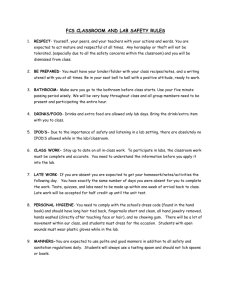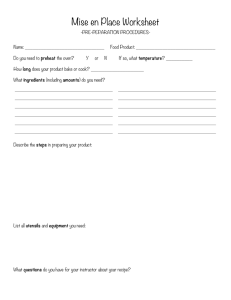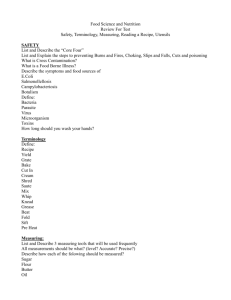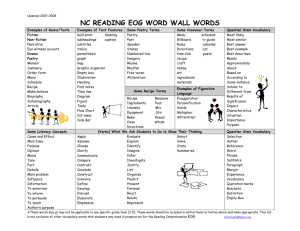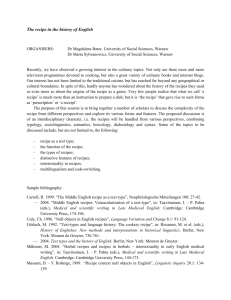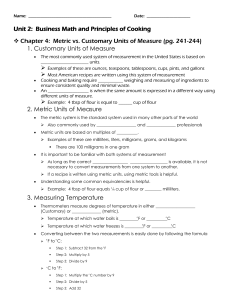Curriculum_Map_ 6th grade 2-14-11
advertisement
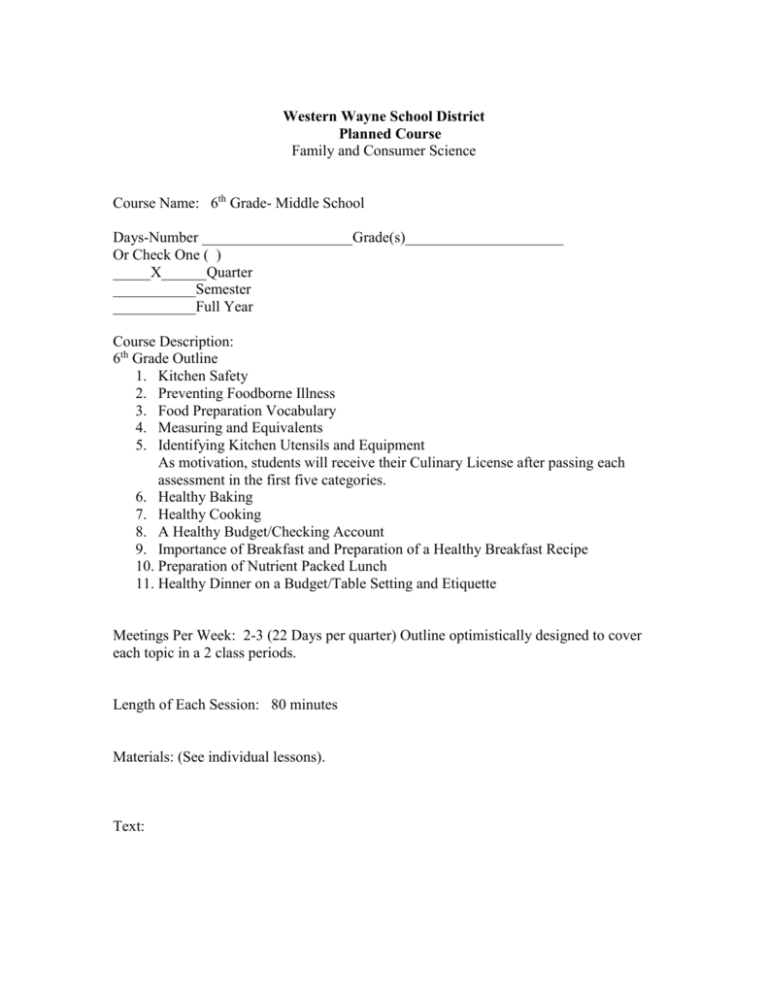
Western Wayne School District Planned Course Family and Consumer Science Course Name: 6th Grade- Middle School Days-Number ____________________Grade(s)_____________________ Or Check One ( ) _____X______Quarter ___________Semester ___________Full Year Course Description: 6th Grade Outline 1. Kitchen Safety 2. Preventing Foodborne Illness 3. Food Preparation Vocabulary 4. Measuring and Equivalents 5. Identifying Kitchen Utensils and Equipment As motivation, students will receive their Culinary License after passing each assessment in the first five categories. 6. Healthy Baking 7. Healthy Cooking 8. A Healthy Budget/Checking Account 9. Importance of Breakfast and Preparation of a Healthy Breakfast Recipe 10. Preparation of Nutrient Packed Lunch 11. Healthy Dinner on a Budget/Table Setting and Etiquette Meetings Per Week: 2-3 (22 Days per quarter) Outline optimistically designed to cover each topic in a 2 class periods. Length of Each Session: 80 minutes Materials: (See individual lessons). Text: Western Wayne School District Planned Course Overview Course Name: Family and Consumer Science Grade: 6 Check one ( ) _____Quarter _____Semester __X___Full Year Time Standards Categories (Days) I.Kitchen Safety 2 11.3.6 B. Describe safe food handling techniques (e.g., storage, temperature control, food preparation, conditions that create a safe working environment for food production). 11.3.3B Describe personal hygiene techniques in food handling (e.g., handwashing, sneeze control, signs of food spoilage). 11.3.3F Identify components of a basic recipe (e.g., volume, weight, fractions, recipe ingredients, recipe directions, safety techniques.) 2 II.Preventing Foodborne Illness 11.3.3 B. Describe safe food handling techniques (e.g., storage, temperature control, food preparation, conditions that create a safe working environment for food production). 11.3.9B Identify the cause, effect and prevention of microbial contamination, parasites and toxic chemicals in food. 11.3.9 Explain how scientific and technological developments enhance our food supply (food preservation). 11.3.3A Know the production steps that a food travels from the farm to consumer. Evaluation(s) Students will remember the safety rules when working in the food lab. Students will evaluate their own hand washing methods. Students will apply safe food handling procedures when working in the food lab. 2 III.Culinary Terminology 11.3.6 FAnalyze basic food preparation techniques and food-handling procedures. 11.3.3F Identify components of a basic recipe (e.g., volume, weight, fractions, recipe ingredients, recipe directions, safety techniques.) 2 IV. Measuring and Equivalents 11.3.6 F Analyze basic food preparation techniques and food-handling procedures. 11.3.6A Demonstrate knowledge of techniques used to evaluate food in various forms (e.g., canned, frozen, dried, irradiated, amounts.) 11.3.3F Identify components of a basic recipe (e.g., volume, weight, fractions, recipe ingredients, recipe directions, safety techniques.) 2 V. Identifying Kitchen Utensils and Equipment 11.3.6F Analyze basic food preparation techniques and food-handling procedures. Students will define the terminology used in food preparation recipes. Students will remember equivalents. Students will be able to calculate the change in ingredient amounts when (i.e. halving/doubling/tripling) changing the amounts of recipes. Students will identify the kitchen utensils, equipment necessary to carry out the production of the recipes prepared in class and at home. 4 VI. Healthy Baking 11.3.6C Analyze factors that affect food choices. 11.3.3C Explain the importance of eating a varied diet in maintaining health. 11.3.9 Explain how scientific and technological developments enhance our food supply. 11.3.3F Identify components of a basic recipe (e.g., volume, weight, fractions, recipe ingredients, recipe directions, safety techniques.) 4 VII. Healthy Cooking 11.3.3D Classify foods by food group within the food guide pyramid including the serving size and nutrition function within the body. 11.3.6D Describe a well-balanced daily menu using the dietary guidelines and the food guide pyramid. 11.3.3F Identify components of a basic recipe (e.g., volume, weight, fractions, recipe ingredients, recipe directions, safety techniques.) Students will prepare healthy recipes based on the knowledge they have learned (Scaffolding effect of information). To prepare Healthy Baked Recipes. Students will apply what they learned to create and prepare cooked recipes based on a healthy diet. 4 VIII. A Healthy Budget/Entrepreneurship 11.1.3B Define the components of a spending plan i.e. (income, expenses and savings) 11.1.6B Know the relationship of the components of a simple spending plan and how that relationship allows for managing income, expenses and savings. 11.2.6F Explain practices to maintain and/or repair consumer goods and services 11.2.9 F Evaluate different strategies to obtain consumer goods and services. 11.1.9B. Explain the responsibilities associated with managing personal finances (e.g. savings, checking, credit, non-cash systems, investments, insurance). Students participate in a simulated checking account. Maintain a budget, and write checks for various fictitious expenses. Students participate in the Junior Achievement Biztown Program. Western Wayne School District Unit Overview Course Name: Grades: Focus Question: (This refers to the “big” question(s) or themes/units. Phrase as a question. What is the problem to be solved?) Time (Days) 2 Essential Question Evaluations(s) I. How are accidents prevented in the Food Lab? Why is it important to follow the safety rules? Students will apply safety rules when creating a recipe. 2 II. What food safety procedures are applied in the classroom and at home to prevent food borne illness? What type of bacteria can be identified that cause food borne illness? Apply safe food handling procedures. 2 III. What is the meaning of various culinary vocabulary and terminology? Students will prepare recipes using the correct methods, terminology, and vocabulary. 2 IV. How do the amount of recipe ingredients change when the yield of the recipe changes? Measuring Stations Measuring worksheet and practice. Application in solving problems when given various challenges to change recipe amounts. 2 V. What kitchen equipment will be used to prepare the recipes in this class? What is the proper way to use the utensils/equipment and how do we use it safely and correctly? Students will choose the correct equipment for recipe completion and use it safely and effectively. 4 VI. How are conventional baked recipes changed to make them healthier and more nutritious? What are the scientific and chemical changes that take place when baking? Students will change conventional high calorie recipes to healthier ones and prepare the recipes during baking labs. 4 VII. How are conventional cooked recipes changed to make them healthier and more nutritious? What are the scientific and chemical changes that take place when cooking? Students will change conventional high calorie recipes to healthier ones and prepare the recipes during cooking labs. What is the correct way to set a formal table. What is proper dining etiquette and why is it important? Students will be given a fictitious checkbook/ledger and checks. Various expenses and income will be given. Students must keep an accurate checkbook ledger. Students will play a grocery shopping game comparing prices 4 VIII. What is the proper way to write out a check? How is a checkbook balanced? What does a check ledger look like? How is a checkbook balanced? What is comparative shopping? Why is it important. of various household items. Western Wayne School District Curriculum Map Grade Level: Marking Period: Days of Instruction Methods and Mathematics Anchor: Instructional Time: Instructional Programming (content/method) I. 2 Intoduction to class rules and safety rules. Emphasis on responsibility, being prepared for class, the serious quest for knowledge and learning. Teacher will demonstrate various safety techniques with equipment in the classroom. Hand washing demonstration. Video on Food Safety Food Safety Quiz Introduction to pathogens and bacteria shown on a “Can you Name this Pathogen” Poster. Teacher lecture and demonstration of sanitation procedures. Sanitation Video *MATH ANCHOR III. Students will be introduced to various culinary terms and vocabulary. Use of flashcards, a word wall to comprehend the meanings along with practical application in recipe preparation. Sanitation Worksheet Teacher Observation of Food Handling Procedures IV. Students will visit (4) measuring stations that will be set up around the room. 1Equivalents (Gallon Man, Equivalents Bingo). 2-Fractions, 3-Adjusting Recipes 4Practical Application (Measure your own brownie mix). *MATH ANCHOR Measuring Stations Each student must complete an exit activity before moving on to the next station. II. 2 2 2 Evaluation Vocabulary Quiz 2 V. Teacher will introduce kitchen utensils/equipment and demonstrate their uses. Students will have a kitchen utensil/equipment scavenger hunt. Students will play the Kitchen Equipment Card Game. 4 VI. Teacher will use a healthy interactive power point presentation to introduce various healthy baking techniques. Preparation of Healthy Baked Recipes 4 VII. Teacher will use a healthy cooking interactive power point presentation to introduce healthy cooking techniques. Preparation of Healthy Cooked Recipes Students will review the correct way to set a table. Etiquette will be discussed Role play etiquette scenarios. Kitchen equipment Quiz. Practical Application and Recipe Implementation. Recipe Analysis, Evaluation, Creation. Recipe Analysis, Evaluation, Creation *Writing Connection – Written Paragraph Evaluating the Recipe and Final Product. *Cultural Connection- Students will preparing recipes from a variety of cultures. Recipe Analysis, Evaluation, Creation *Writing Connection *Cultural Connection Quiz on Tablesetting 4 VIII. *MATH ANCHOR Students will participate in a checking account simulation activity. Students will be given a choice to purchase three items within the same category at different costs. Students must Analyze and compare three products before making a simulated purchase. Students will be given a scenario in which something breaks, students must choose the means of repair by analyzing three services. Students will balance a checkbook ledger and write checks.
